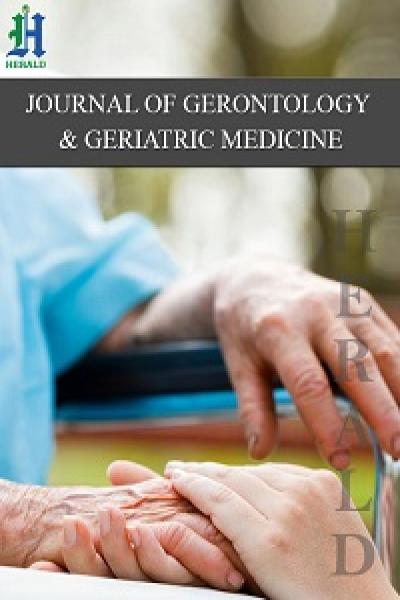
Rising Significance of Dynapenic Abdominal Obesity in Chronic Kidney Disease: Insights from a Chinese Cohort
*Corresponding Author(s):
Zhipeng ChenSchool Of Medical Technology, Jiangsu College Of Nursing, No.9 Keji Road, Qingjiangpu District, Huai’an City, Jiangsu Province, China
Tel:+86 19852561923,
Email:chen.zhip@foxmail.com
Abstract
The aim of this commentary is to highlight the divergent impact of Dynapenic Abdominal Obesity (D/AO) on Chronic Kidney Disease (CKD) risk in middle-aged versus older adults. Based on a nationwide prospective cohort study (CHARLS, N = 5,932), D/AO conferred a 2.4-fold higher CKD risk in middle-aged adults (OR 2.40; 95% CI 1.14–4.59; p=0.01), while no significant association was observed in older populations (OR 1.56; 95% CI 0.96–2.46; p=0.06). These findings underscore the urgent need for age-stratified prevention strategies targeting muscle strength and visceral adiposity.
Keywords
Abdominal obesity; Age disparity; China Health and Retirement longitudinal study; Chronic kidney disease; Dynamic
Introduction
Chronic Kidney Disease (CKD) affects 8.2% of Chinese adults, with aging populations bearing the greatest burden [1,2]. Dynapenic Abdominal Obesity (D/AO)—a confluence of low muscle strength (dynapenia) and abdominal obesity—has emerged as a novel risk factor for CKD, yet its age-specific implications remain unexplored [3]. This commentary discusses key findings from our prospective cohort study investigating D/AO and CKD risk in Chinese adults aged ≥45 years.
Key Findings
Overall cohort
D/AO was associated with 57% higher CKD incidence after multivariable adjustment (OR 1.57; 95% CI 1.03-2.35).
Age disparity
Middle-aged adults (45-59 years): D/AO elevated CKD risk by 140% (OR 2.40; 95% CI 1.14-4.59; p = 0.01).
Older adults (≥60 years): No significant association (OR 1.56; 95% CI 0.96-2.46; p = 0.06).
Screening utility
Handgrip strength (< 28 kg men, < 18 kg women) and waist circumference (≥90 cm men, ≥85 cm women) offered a low-cost tool for identifying high-risk individuals.
Interpretation and Implications
Biological mechanisms
The synergy between dynapenia and visceral adiposity may accelerate renal decline through:
- Inflammatory crosstalk: Visceral fat elevates pro-fibrotic cytokines (e.g., IL-6), while muscle atrophy reduces nephroprotective myokines (e.g., irisin) [4,5]
- Metabolic dysregulation: Ectopic lipid deposition promotes insulin resistance and podocyte injury [6]
Clinical practice
- Middle-aged adults: D/AO screening via grip strength and waist circumference should be integrated into routine health checks. Early interventions (e.g., resistance training, dietary management) may mitigate CKD risk [7]
- Older adults: Competing risks (e.g., cardiovascular mortality) may mask D/AO’s impact; holistic comorbidity management is prioritized [8].
Public health perspective
- Prevention focus: Midlife interventions targeting D/AO could reduce CKD burden in aging societies
- Policy action: National health programs should incorporate musculoskeletal-metabolic health metrics into CKD surveillance
Unresolved questions
- Do mitochondrial dysfunction or gut-kidney axis disruptions mediate the age-specific effects of D/AO?
- Can resistance training combined with nutritional interventions delay CKD onset in high-risk middle-aged adults?
- Why does D/AO’s renal impact attenuate in older populations? Is this due to survivorship bias or physiological adaptations?
Conclusion
D/AO is a modifiable CKD risk factor with age-stratified clinical relevance. Public health policies must prioritize midlife interventions while adapting geriatric care to address multifactorial risks. Our findings advocate for integrating musculoskeletal and metabolic health into CKD prevention frameworks—a step toward precision public health.
Acknowledgment
We thank the China Health and Retirement Longitudinal Study team for collecting the data and making the data publicly accessible.
Conflicts of Interest
The authors declare no conflicts of interest.
References
- Wu MF, Lee CH, Pai PH, Wang JM (2023) Screening Cases of Suspected Early Stage Chronic Kidney Disease from Clinical Laboratory Data: The Comparison between Urine Conductivity and Urine Protein. Biomedicines 11: 379.
- Chen YM, Zhao ZP, Zhang M, Zhang X, Li C, et al. (2025) [Prevalence of chronic kidney disease and risk factors in adults with hypertension in China]. Zhonghua Liu Xing Bing Xue Za Zhi 46: 33-42.
- Choi Y, Cho J, Kim J, Bae JH, Cho EJ,et al. (2022) Dynapenic-abdominal obesity as an independent risk factor for chronic kidney disease in postmenopausal women: A population-based cohort study. Menopause 29: 1040-1046.
- Dousdampanis P, Aggeletopoulou I, Mouzaki A (2024) The role of M1/M2 macrophage polarization in the pathogenesis of obesity-related kidney disease and related pathologies. Front Immunol 15: 1534823.
- Rezus E, Burlui A, Cardoneanu A, Rezus C, Codreanu C, et al. (2020) Inactivity and Skeletal Muscle Metabolism: A Vicious Cycle in Old Age. Int J Mol Sci 21: 592.
- Yan J, Xie Y, Wang F, Chen Y, Zhang J, et al. (2020) Carbon ion combined with tigecycline inhibits lung cancer cell proliferation by inducing mitochondrial dysfunction. Life Sci 263: 118586.
- Narvaez G, Apaflo J, Wagler A, McAinch A, Bajpeyi S (2025) The additive effect of neuromuscular electrical stimulation and resistance training on muscle mass and strength. Eur J Appl Physiol 125: 1687-1700.
- Betriu A, Martinez-Alonso M, Arcidiacono MV, Cannata-Andia J, Pascual J, et al. (2014) Prevalence of subclinical atheromatosis and associated risk factors in chronic kidney disease: the NEFRONA study. Nephrol Dial Transplant 29: 1415-1422.
Citation: Chen Z, Zhao F, Li S, Zhu L (2025) Rising Significance of Dynapenic Abdominal Obesity in Chronic Kidney Disease: Insights from a Chinese Cohort. HSOA J Gerontol Geriatr Med 11: 255.
Copyright: © 2025 Zhipeng Chen, et al. This is an open-access article distributed under the terms of the Creative Commons Attribution License, which permits unrestricted use, distribution, and reproduction in any medium, provided the original author and source are credited.

